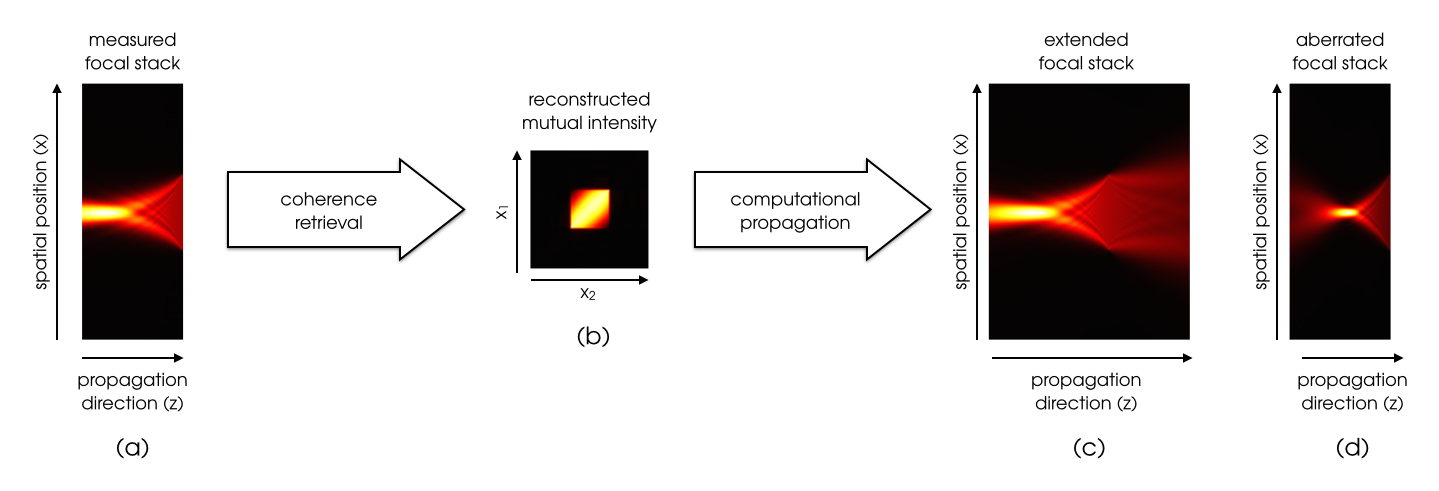Coherence Retrieval (Phase Space Tomography)
By capturing the amplitude and phase profile at the cross section of a coherent light beam, we can predict its behavior at a macroscopic time scale when traversing known optical systems. Such is the basis for holography, where a coherent field can be recorded, and then reconstructed physically or propagated digitally. However, most light we encounter everyday is not coherent, but rather partially coherent, and hence simply the amplitude and phase is not enough to capture the information contained in such beams; in fact, phase has no defined value in a partially coherent beam as it is stochastically varying. What is sufficient is a recording of the two-point correlation of the field—for the polychromatic case, this information is contained in the mutual coherence function or cross spectral density, and for the quasimonochromatic case, this information is given by the mutual intensity or phase space representations such as the Wigner distribution or the ambiguity function.

Although we are interested in a correlation function, the standard signal processing method of estimating correlation using measurements of many realizations is not feasible for most optical applications, because the oscillations of the electromagnetic field are much too fast for any currently available apparatus to capture directly. What can be measured is time-averaged intensity of the field in question, perhaps after it has propagated through some linear optical system(s) of our own choosing. We can then estimate the correlation function by solving an inverse problem based on these measurements, in a process called coherence retrieval or phase space tomography. The latter term derives from the fact that intensity cross-sections of a partially coherent beam correspond to projections of the Wigner distribution or slices of the ambiguity function, and thus focal stacks or apparatuses with cylindrical lenses have been the focus of most of the physics literature. In the geometric optics limit, phase space tomography becomes light field imaging, which has recently spawned many sensing and illumination applications in the computer graphics literature.
$ \begin{aligned} \underset{\vec{J}}{\arg\min}& \sum_{m=1}^M \sigma_m^{-2}\left(y_m - \vec{k}^{\mathsf H}_m \vec{J} \vec{k}_m\right)^2 \\ \text{subject to } &\vec{J} \succeq \vec{0} \end{aligned} \quad $
$ \quad \begin{aligned} &\underset{\vec{X}}{\arg\min} \sum_{m=1}^M \sigma_m^{-2}\left(y_m - \vec{k}^{\mathsf H}_m \vec{X}\vec{X}^{\mathsf H} \vec{k}_m\right)^2 \end{aligned} $
We have formulated coherence retrieval as a constrained least squares problem that ensured results were physically valid while assuming weighted Gaussian measurement noise. The formulation can be applied to any measurement system as long as the system impulse response is known and measurement noise can be adequately modeled as Gaussian. A factorization approach was used to convert the formulation into an unconstrained problem, which could be solved using a nonlinear conjugate gradients algorithm called factored form descent. We have used this approach to initially solve for the mutual intensity of a 1D Schell-model source, and current work includes adding regularizers and preconditioners to improve convergence, investigating new capture protocols to exploit the versatility of the formulation, and using recent state-of-the-art convex optimization approaches to solve this inverse problem.
Relevant Articles and Conference Proceedings
- Zhengyun Zhang, and George Barbastathis, "Regularizers for Coherence Retrieval and Their Physical Interpretation," in Classical Optics 2014, OSA Technical Digest (online) (Optical Society of America, 2014), paper CW4C.4
- Zhengyun Zhang, and George Barbastathis, "Compressive Effects of Positivity in Coherence Retrieval," in Imaging and Applied Optics, OSA Technical Digest (online) (Optical Society of America, 2013), paper CTu3C.4
- Lei Tian, Zhengyun Zhang, Jonathan C. Petruccelli, and George Barbastathis, "Wigner function measurement using a lenslet array," Opt. Express 21, 10511–10525 (2013)
- Zhengyun Zhang, Zhi Chen, Shakil Rehman, and George Barbastathis, "Factored form descent: a practical algorithm for coherence retrieval," Opt. Express 21, 5759–5780 (2013)
- Zhengyun Zhang, and Marc Levoy, "Wigner distributions and how they relate to the light field," in Computational Photography (ICCP), 2009 IEEE International Conference on, 1–10 (2009)